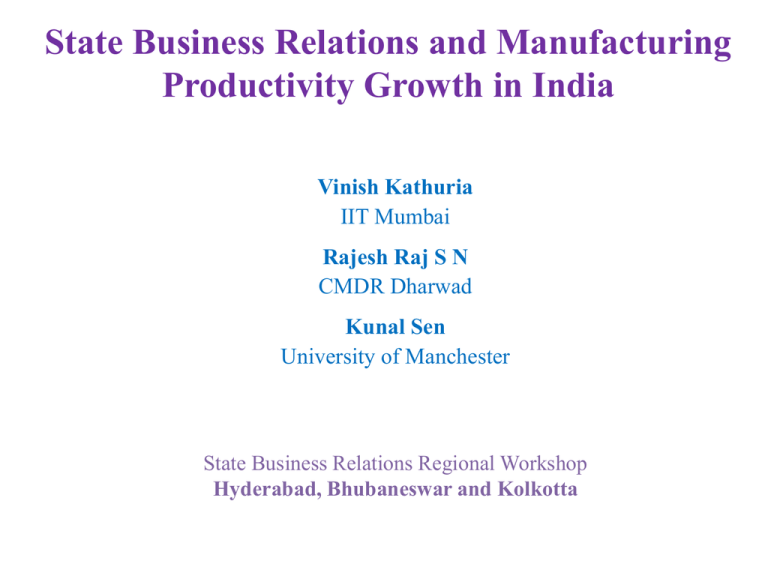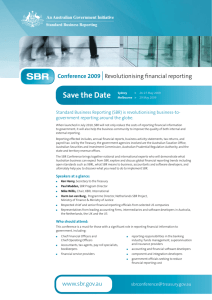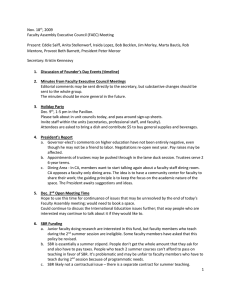State Business Relations and Manufacturing Productivity Growth in India Vinish Kathuria
advertisement

State Business Relations and Manufacturing Productivity Growth in India Vinish Kathuria IIT Mumbai Rajesh Raj S N CMDR Dharwad Kunal Sen University of Manchester State Business Relations Regional Workshop Hyderabad, Bhubaneswar and Kolkotta Presentation Outline Introduction Methodology and Data Measuring SBR in India SBR and State Level Growth SBR and Industry Level TFPG SBR and Firm Level TFPG Conclusions 1. Introduction Evidence points to the existence of significant degree of heterogeneity in productivity across firms even within narrowly defined manufacturing industries (Bartelsman and Doms, 2000; Tybout, 2000). Several attempts were made to understand the factors influencing productivity growth (e.g., the role of trade openness and market structure - Chand & Sen 2002, Goldar & Kumari, 2003; Ural & Mitra, 2007) … but failed to identify the role that institutions can play in influencing industrial performance 12/16/2009 SBR and Manuf Productivity 3 1. Introduction contd… This paper investigates the role of a specific set of institutions – effective state business relations - in explaining productivity growth across industries. Indian mfrg an ideal milieu for the analysis as despite the dismantling of the License Raj regime and significant trade liberalization since the 1990s, disparities in regional performance still persist and convergence of industrial productivity growth across Indian States has not happened. 12/16/2009 SBR and Manuf Productivity 4 2. Methodology and Data • Growth equation estimation: to establish the relationship between SBR and TFPG • TFP - the portion of output not explained by the amount of inputs used in production • TFPG is computed using Levinsohn and Petrin (LP) Method which helps to correct the endogeneity bias • an observable firm characteristic – intermediate inputs – is used to proxy the unobserved firm productivity and estimate unbiased production function coefficients • Organized sector – ASI data for 1994-95, 2000-01 and 2004-05 and Unorganized sector – NSSO Survey data for 1994-95, 2000-01 and 2005-06 12/16/2009 SBR and Manuf Productivity 5 3. Measuring SBR in Indian States 1. How is the private sector organised? 2. How is the public sector organised? 3. Practice of SBRs 4. Presence of Collusive SBRs Each given equal weight; coded from 0 to 1; and aggregated to form an overall measure of SBR (which varies from 0 to 1) 3. Measuring SBR in Indian States contd… How is the private sector organised? • Is there an umbrella business association and when did it come into being? • Whether the private sector association has a website or not, and since when? - proxy for quality of organisational structure and outside visibility • How frequently the website is updated – efficiency of internal processes and level of activity • Is the office of the assoc owned or not? – level of organisation’s resources • We look at the main private sector assoc for the state, and the two leading industry assocs. 3. Measuring SBR in Indian States contd… How is the public sector organised? • The presence of state owned or state participated productive corporations, which are investment promotion agencies, financial, infrastructure development and tourism development corporations. • The governments’ signalling of their relative priorities through the allocation of public resources to productive sectors – share of economic services in total govt expenditures. 3. Measuring SBR in Indian States contd… How is SBR practised? • Labour regulation – Labour laws in India are mostly state-specific, and different states have enacted changes in labour laws, which are either pro-workers/antibusiness or pro-employer (Tim Besley and Robin Burgess have coded these changes in laws) – closer degree of state-business interaction reflects in proemployer labour market regulation • Stamp duty as a measure of the attitude of the state governments towards business establishments and their expansion – tax on transfer of properties and instruments used in commercial and business transactions 3. Measuring SBR in Indian States contd… What are the mechanisms to avoid collusive behaviour? • The gross output of firms belonging to delicensed industries as a proportion of total industrial GDP – exogenous source of change in the extent of collusive behaviour at the state level • Whether the private sector umbrella association has a regular publication informing its members (and from when) – captures transparency of organisation’s activities • The frequency with which the publication is produced and distributed – indicates the level of transparency 3. Measuring SBR in Indian States contd… Figure 1: Evolution of the Effectiveness of State Business Relation measure in Indian States, 1985-2006 Assam Bihar Gujarat Haryana Karnataka Kerala Madhya Pradesh Maharashtra Orissa Punjab Rajasthan Tamil Nadu Uttar Pradesh Uttarakhand West Bengal .3 .4 .5 .6 .7 .3 .4 .5 .6 .7 .3 .4 .5 .6 .7 SBR index .3 .4 .5 .6 .7 Andhra Pradesh 1980 1990 2000 2010 1980 1990 2000 2010 1980 Year Graphs by statenm 1990 2000 2010 1980 1990 2000 2010 4. SBR and State Level Growth Dynamic panel data regressions, with 15 states and for the period, 1985-2004 Controls: Year-specific national level shocks, e.g. weather shocks State specific effects: innate cultural and geographical properties of states An one per cent increase in the SBR measure leads to a three per cent increase in long-run growth of Indian states. West Bengal’s growth rate would have been appreciably higher in 1985-2004 if it had a more effective SBR, especially in the 1980s. We also find that strengthening the actual practice of SBRs (SBR Practice) was the key to SBR’s role in economic growth rather than the establishment of formal organisations to carry out such interactions (SBR Public). 5. SBR and Industry Level Growth Pooled the data for two distinct time periods – 1994 to 2001 and 2001 to 2006, to see the impact of SBR on TFPG Controls: trade and competition policy variables Included year and industry dummies We find that effective SBR has a direct impact on the TFPG of the manufacturing sector. The effect is however confined to the formal manufacturing sector. This supports the existence of duality in Indian manufacturing. It is quite possible that a favourable business climate may be signaling firms in informal sector to relocate to the states having good SBR. But once relocated, they may not gain much as the presence of effective SBR in the state primarily affects the formal manufacturing sector. 6. SBR and Firm Level Growth We also analysed the impact of SBR measure on firm performance, controlling for size, age, location and nature of organisation of the firm Smaller firms, firms in urban areas, older firms and firms with simpler organisation structures (less public participation) do better with better SBR. SBR private, practice and collusive components contribute to the overall impact of effective SBR on firm performance while SBR public seems to have a negative effect on TFP. The study suggests that it is important to improve the quality of public goods provided by the sub-national state governments which can further enhance the impact of other sub-components. 7. Conclusion We find that the formalized institutions involving state and business affecting productivity of formal sector may not have much relevance for the informal sector as such. Our study shows that collaborative relationships between the state and the business sector can be performance enhancing and the goal of policy should be to strengthen such relationships. Thank You

